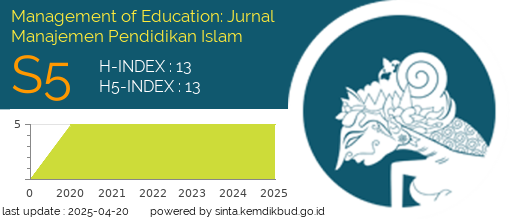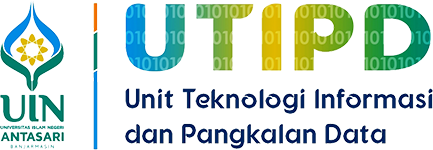Effect of Physical Work Environment, Workload and Tenure on Teacher Performance at High School
DOI:
https://doi.org/10.18592/moe.v11i2.16802Keywords:
Physical Work Environment, Workload, Tenure, Teacher PerformanceAbstract
This study aims to analyze the effect of physical work environment, workload, and tenure on teacher performance at SMA Negeri 1 Basa Ampek Balai, Pesisir Selatan Regency. Specifically, this study evaluates: (1) the effect of physical work environment on teacher performance; (2) the effect of workload on teacher performance; (3) the effect of tenure on teacher performance; and (4) the simultaneous effect of physical work environment, workload, and tenure on teacher performance. This study used a quantitative approach with a total sampling technique, in which the entire population of 50 teachers was sampled. The results of the analysis showed that: (1) the physical work environment has a positive and significant effect on teacher performance; (2) workload has a negative and significant effect on teacher performance; (3) tenure has a positive and significant effect on teacher performance; and (4) simultaneously, the physical work environment, workload, and tenure have a positive and significant effect on teacher performance at SMA Negeri 1 Basa Ampek Balai. These findings confirm the importance of creating a conducive work environment, managing workload proportionally, and recognizing tenure in efforts to improve teacher performance.References
Arifuddin, A., & Ryman Napirah, M. (2015). Hubungan Disiplin Dan Beban Kerja Dengan Kinerja Perawat Di Ruang Rawat Inap Rumah Sakit Umum Daerah (RSUD) Undata Palu. Healthy Tadulako Journal (Jurnal Kesehatan Tadulako), 1(1), 29-38. https://doi.org/10.22487/htj.v1i1.4
Aladetan, F. I. (2023). Work Environment and Teachers’ Job Performance in Public Primary Schools in Ondo State Nigeria. International Journal of Education, Teaching, and Social Sciences, 3(1), 68–81. https://doi.org/10.47747/ijets.v3i1.846
Alex, N. (2019). Manajemen sumber daya manusia. Pustaka Setia.
Al Horr, Y., Arif, M., Kaushik, A., Mazroei, A., Katafygiotou, M., & Elsarrag, E. (2016). Occupant productivity and office indoor environment quality: A review of the literature. Building and Environment, 105, 369–389. https://doi.org/10.1016/j.buildenv.2016.06.001
Anwar, M., Khan, T. M., & Jabbar, M. N. (2022). Relationship between Working Environment and Teachers Performance: An Empirical Study. Global Sociological Review, VII(II), 63–69. https://doi.org/10.31703/gsr.2022(VII-II).07
Bakker, A. B., Xanthopoulou, D., & Demerouti, E. (2023). How does chronic burnout affect dealing with weekly job demands? A test of central propositions in JD‐R and COR‐theories. Applied Psychology, 72(1), 389–410. https://doi.org/10.1111/apps.12382
Dani, A. R., & Mujanah, S. (2020). Pengaruh servant leadership, beban kerja dan kreativitas terhadap kinerja karyawan Dinas Perhubungan Kabupaten Bangkalan Madura dengan komitmen organisasi sebagai variabel intervening. Media Mahardhika, 19(1), 434-445. https://doi.org/10.29062/mahardika.v19i3.269
Danim, S. (2020). Motivasi kepemimpinan dan efektivitas kelompok. PT Rineka Cipta.
Darmadi, H. (2020). Metode penelitian pendidikan sosial. Alfabeta.
Day, C., & Gu, Q. (2009). Veteran teachers: Commitment, resilience and quality retention. Teachers and Teaching: Theory and Practice, 15(4), 441–457. https://doi.org/10.1080/13540600903057211
Erien Miranti, & Herkulana, Y. Y. (2021). Pengaruh tingkat pendidikan, masa kerja dan motivasi kerja terhadap kinerja pegawai. E-Jurnal Pendidikan dan Pembelajaran Khatulistiwa, 5(3). https://doi.org/10.26418/jppk.v5i3.14462
Ferreira, M., Barqueira, A., Reis-Jorge, J., Pacheco, P., Brito, R., & Baltazar, I. (2024). Physical and mental wellbeing, teaching efficacy and school connectedness—A study with preschool teachers in Portugal. Frontiers in Education, 9, 1408544. https://doi.org/10.3389/feduc.2024.1408544
Fazira, I., Radiana, U., Wahyudi, W., & Wicaksono, L. (2023). Pengaruh Motivasi Kerja dan Pengalaman Kerja Terhadap Kinerja Guru Profesional. Al-Madrasah: Jurnal Pendidikan Madrasah Ibtidaiyah, 7(3), 1314. https://doi.org/10.35931/am.v7i3.2436
Hasibuan, M. S. P. (2014). Manajemen sumber daya manusia. Bumi Aksara.
Ingersoll, R. M., & Strong, M. (2011). The impact of induction and mentoring programs for beginning teachers: A critical review of the research. Review of Educational Research, 81(2), 201–233. https://doi.org/10.3102/0034654311403323
Kim, K.-N. (2019). Teachers’ administrative workload crowding out instructional activities. Asia Pacific Journal of Education, 39(1), 31–49. https://doi.org/10.1080/02188791.2019.1572592
Klassen, R. M., & Chiu, M. M. (2010). Effects on teachers’ self-efficacy and job satisfaction: Teacher gender, years of experience, and job stress. Journal of Educational Psychology, 102(3), 741–756. https://doi.org/10.1037/a0019237
Lutfah, A., Hariyati, N., & Handayaningrum, W. (2019). Improved Teacher Performance Through Work Culture and Environment. International Journal for Educational and Vocational Studies, 1(8), 859. https://doi.org/10.29103/ijevs.v1i8.2240
Maharja, R. (2020). Analisis tingkat kelelahan kerja berdasarkan beban kerja fisik perawat di instalasi rawat inap RSU Haji Surabaya. The Indonesian Journal of Occupational Safety and Health, 4(1), 93–102. https://doi.org/10.20473/ijosh.v4i1.2015.93-102
Mangkunegara, A. A. P. (2011). Manajemen sumber daya manusia perusahaan. Remaja Rosdakarya.
Mapano, L. J. S., & Ubayubay, R. M. (2024). Teaching Workload and Burnout Experiences among the Elementary School Teachers of Talakag-I District. International Journal of Research Publications, 144(1). https://doi.org/10.47119/IJRP1001441320246137
Muri, Y. (2021). Metode penelitian: Metode penelitian kuantitatif, kualitatif, dan penelitian gabungan. Prenadamedia Group.
Ng, T. W. H., & Feldman, D. C. (2010). Organizational Tenure and Job Performance. Journal of Management, 36(5), 1220–1250. https://doi.org/10.1177/0149206309359809
Nwoko, C., Adeyemi, T., & Musa, R. (2024). School organizational structure and classroom dynamics: Impact on teacher performance and wellbeing. Journal of Educational Leadership, 12(1), 45–59. https://doi.org/10.1234/jel.v12i1.2024
Rohmah, L. (2021). Pengaruh ergonomi ruang kerja terhadap kinerja guru di sekolah dasar. Jurnal Pendidikan dan Profesi Kependidikan, 5(3), 212–220.
Sanlao, C., Buenavidez, E., & Baluyos, G. (2024). School Work Environment in Relation to Teacher Motivation and Teaching Competencies. Journal of Multidisciplinary Studies, 13(1). https://doi.org/10.62249/jmds.2013.2440
Sastradipoera, K. (2020). Manajemen sumber daya manusia: Suatu pendekatan fungsi operatif. Kappa Sigma.
Sedarmayanti. (2021). Manajemen sumber daya manusia. PT Refika Aditama.
Skaalvik, E. M., & Skaalvik, S. (2017). Still motivated to teach? A study of school context variables, stress and job satisfaction among teachers in senior high school. Social Psychology of Education, 20, 15–37. https://doi.org/10.1007/s11218-016-9363-9
Srivastava, C., Murnane, E. L., Billington, S. L., & Samuelson, H. W. (2024). Impact of workplace design on perceived work performance and well-being: Home versus office. Journal of Environmental Psychology, 95, 102274. https://doi.org/10.1016/j.jenvp.2024.102274
Sudarmanto. (2021). Kinerja dan pengembangan kompetensi SDM. Pustaka Pelajar.
Sugiyono. (2021). Metode penelitian kuantitatif, kualitatif, R&D. Alfabeta.
Toropova, A., Myrberg, E., & Johansson, S. (2021). Teacher job satisfaction: The importance of school working conditions and teacher characteristics. Educational Review, 73(1), 71–97. https://doi.org/10.1080/00131911.2019.1705247
Vischer, J. C. (2008). Towards an environmental psychology of workspace: How people are affected by environments for work. Architectural Science Review, 51(2), 97–108. https://doi.org/10.3763/asre.2008.5114
Downloads
Published
How to Cite
Issue
Section
License
Copyright (c) 2025 Sasra Mulyadi, Didi Aryadi

This work is licensed under a Creative Commons Attribution 4.0 International License.
Authors who publish with this journal agree to the following terms:
- Authors retain copyright and grant the journal right of first publication with the work simultaneously licensed under a Creative Commons Attribution 4.0 International that allows others to share the work with an acknowledgement of the work's authorship and initial publication in this journal.
- Authors are able to enter into separate, additional contractual arrangements for the non-exclusive distribution of the journal's published version of the work (e.g., post it to an institutional repository or publish it in a book), with an acknowledgement of its initial publication in this journal.
- Authors are permitted and encouraged to post their work online (e.g., in institutional repositories or on their website) prior to and during the submission process, as it can lead to productive exchanges, as well as earlier and greater citation of published work.









 This work is licensed under a
This work is licensed under a 